Mutagenesis of the Shigella flexneri autotransporter IcsA reveals novel functional regions involved in IcsA biogenesis and recruitment of host neural Wiscott-Aldrich syndrome protein
- PMID: 18456802
- PMCID: PMC2446779
- DOI: 10.1128/JB.00093-08
Mutagenesis of the Shigella flexneri autotransporter IcsA reveals novel functional regions involved in IcsA biogenesis and recruitment of host neural Wiscott-Aldrich syndrome protein
Abstract
The IcsA (VirG) protein of Shigella flexneri is a polarly localized, outer membrane protein that is essential for virulence. Within host cells, IcsA activates the host actin regulatory protein, neural Wiskott-Aldrich syndrome protein (N-WASP), which in turn recruits the Arp2/3 complex, which nucleates host actin to form F-actin comet tails and initiate bacterial motility. Linker insertion mutagenesis was undertaken to randomly introduce 5-amino-acid in-frame insertions within IcsA. Forty-seven linker insertion mutants were isolated and expressed in S. flexneri Delta icsA strains. Mutants were characterized for IcsA protein production, cell surface expression and localization, intercellular spreading, F-actin comet tail formation, and N-WASP recruitment. Using this approach, we have identified a putative autochaperone region required for IcsA biogenesis, and our data suggest an additional region, not previously identified, is required for N-WASP recruitment.
Figures

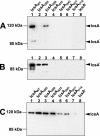

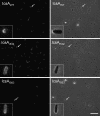
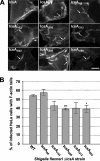
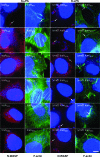
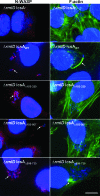
Similar articles
-
Absence of O antigen suppresses Shigella flexneri IcsA autochaperone region mutations.Microbiology (Reading). 2012 Nov;158(Pt 11):2835-2850. doi: 10.1099/mic.0.062471-0. Epub 2012 Aug 30. Microbiology (Reading). 2012. PMID: 22936034
-
Identification of Shigella flexneri IcsA residues affecting interaction with N-WASP, and evidence for IcsA-IcsA co-operative interaction.PLoS One. 2013;8(2):e55152. doi: 10.1371/journal.pone.0055152. Epub 2013 Feb 6. PLoS One. 2013. PMID: 23405119 Free PMC article.
-
The Shigella Virulence Factor IcsA Relieves N-WASP Autoinhibition by Displacing the Verprolin Homology/Cofilin/Acidic (VCA) Domain.J Biol Chem. 2017 Jan 6;292(1):134-145. doi: 10.1074/jbc.M116.758003. Epub 2016 Nov 23. J Biol Chem. 2017. PMID: 27881679 Free PMC article.
-
Molecular and Cellular Mechanisms of Shigella flexneri Dissemination.Front Cell Infect Microbiol. 2016 Mar 11;6:29. doi: 10.3389/fcimb.2016.00029. eCollection 2016. Front Cell Infect Microbiol. 2016. PMID: 27014639 Free PMC article. Review.
-
Actin-based bacterial motility.Curr Opin Cell Biol. 1995 Feb;7(1):94-101. doi: 10.1016/0955-0674(95)80050-6. Curr Opin Cell Biol. 1995. PMID: 7755995 Review.
Cited by
-
IcsA autotransporter passenger promotes increased fusion protein expression on the cell surface.Microb Cell Fact. 2012 Feb 7;11:20. doi: 10.1186/1475-2859-11-20. Microb Cell Fact. 2012. PMID: 22309506 Free PMC article.
-
Evolutionary Perspectives on the Moonlighting Functions of Bacterial Factors That Support Actin-Based Motility.mBio. 2019 Aug 27;10(4):e01520-19. doi: 10.1128/mBio.01520-19. mBio. 2019. PMID: 31455648 Free PMC article. Review.
-
Multiple driving forces required for efficient secretion of autotransporter virulence proteins.J Biol Chem. 2015 Apr 17;290(16):10104-16. doi: 10.1074/jbc.M114.629170. Epub 2015 Feb 10. J Biol Chem. 2015. PMID: 25670852 Free PMC article.
-
The Shigella flexneri type 3 secretion system is required for tyrosine kinase-dependent protrusion resolution, and vacuole escape during bacterial dissemination.PLoS One. 2014 Nov 18;9(11):e112738. doi: 10.1371/journal.pone.0112738. eCollection 2014. PLoS One. 2014. PMID: 25405985 Free PMC article.
-
Interactions between Shigella flexneri and the Autophagy Machinery.Front Cell Infect Microbiol. 2016 Feb 10;6:17. doi: 10.3389/fcimb.2016.00017. eCollection 2016. Front Cell Infect Microbiol. 2016. PMID: 26904515 Free PMC article. Review.
References
-
- Baker, S., J. Gunn, and R. Morona. 1999. The Salmonella typhi melittin resistance gene pqaB affects intracellular growth in PMA-differentiated U937 cells, polymyxin B resistance and lipopolysaccharide. Microbiology 145367-378. - PubMed
-
- Berthiaume, F., N. Rutherford, and M. Mourez. 2007. Mutations affecting the biogenesis of the AIDA-I autotransporter. Res. Microbiol. 158348-354. - PubMed
-
- Brahmbhatt, H. N., A. A. Lindberg, and K. N. Timmis. 1992. Shigella lipopolysaccharide: structure, genetics, and vaccine development. Curr. Top. Microbiol. Immunol. 18045-64. - PubMed
-
- Brandon, L. D., N. Goehring, A. Janakiraman, A. W. Yan, T. Wu, J. Beckwith, and M. B. Goldberg. 2003. IcsA, a polarly localized autotransporter with an atypical signal peptide, uses the Sec apparatus for secretion, although the Sec apparatus is circumferentially distributed. Mol. Microbiol. 5045-60. - PubMed
Publication types
MeSH terms
Substances
LinkOut - more resources
Full Text Sources

